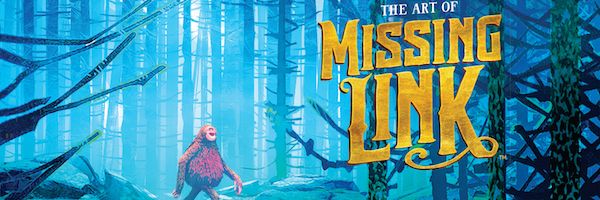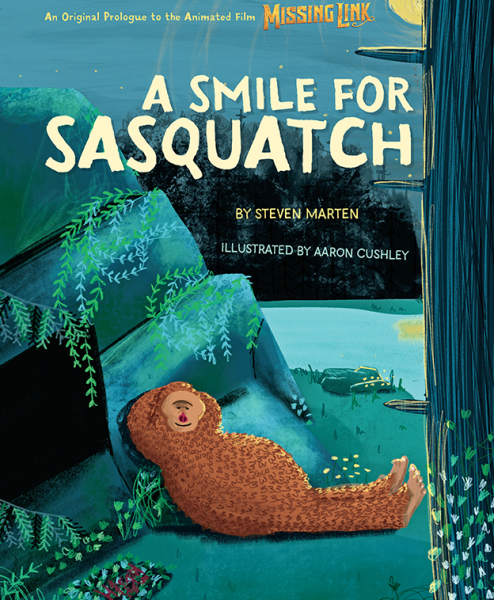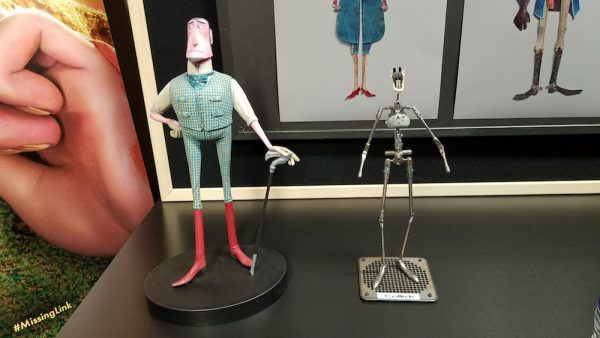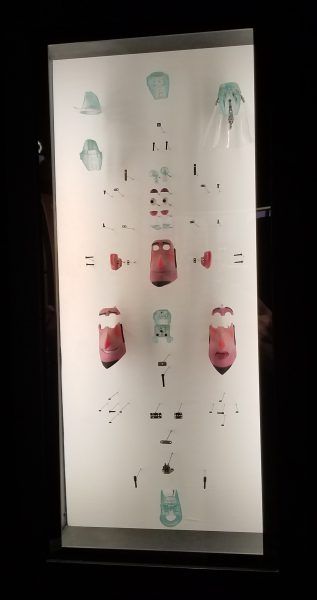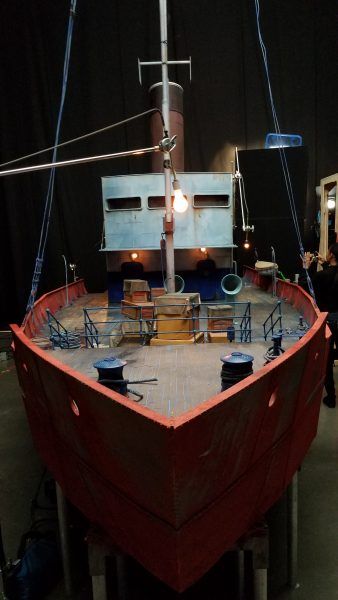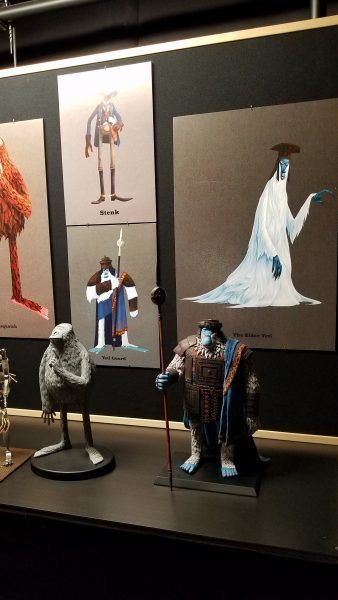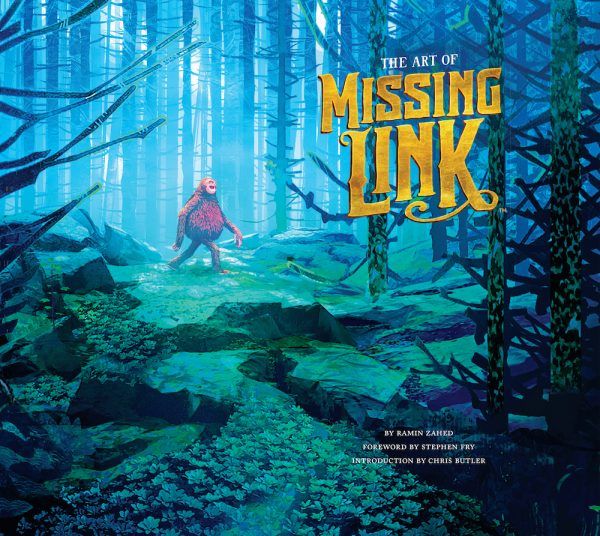From LAIKA, the animation studio behind the Oscar-nominated Kubo and the Two Strings, Coraline, and ParaNorman, comes Missing Link, a stunning, epic, raucous stop-motion comedy out in theaters April 12th. Insight Editions and LAIKA have collaborated for The Art of Missing Link, a must-have companion to the film featuring featuring concept art from the film’s creation—including sketches, storyboards, character designs, and much more.
I'm torn. On one hand, I want you to run out and see LAIKA's new stop-motion animated film Missing Link as soon as humanly possible. On the other hand, I want you to have Insight Edition's new companion book "The Art of Missing Link" cracked open in front of you ahead of time so that you can better start to appreciate the Herculean amount of work, artistry, and talent that went into making this movie. The book is available today, so my advice would be to pre-order the book, then see the film in theaters opening day, then read the 176-page tome to take a deep dive into everything you missed in Missing Link before seeing the movie again ASAP. That's the ideal way to embark on this particular adventure, in my humble opinion.
Written by Ramin Zahed, with a foreword by Stephen Fry (who stars in the film as Lord Piggot-Dunceb) and an introduction by the film's Oscar-nominated writer-director Chris Butler (ParaNorman), "The Art of Missing Link" is a lushly illustrated collector's item that goes behind the scenes of LAIKA’s new stop-motion adventure to showcase the studio's cutting-edge technology, the filmmakers’ meticulous attention to detail, and the one-of-a-kind artwork from the making of the film. Zahed's commentary is restrained here, opting to let the many and varied images tell the tale of the making of Missing Link along with quotes from LAIKA's talented team that point out details and reveal incredible trivia tidbits. One of the most striking layouts in the whole book is a series of side-by-side before-and-after shots revealing the on-set reality and the finished feature film frame, but there are gems on each and every page. I've gathered some of the awesome facts I learned from this book (complemented by my own visit to LAIKA for this movie), along with a short spoiler section for folks who are reading this after seeing the movie. (Keep an eye out for my review of Missing Link later this week!)
But first! There's another Missing Link tie-in book that you can pick up and read right now, a prequel story titled "A Smile for Sasquatch." This short kids book, weighing in at only 32 pages, introduces the title character and his happy home. Wonderfully written by Steven Marten and beautifully illustrated by Aaron Cushley, this Insight Kids title is an original story that captures the heart and the visual appeal of Missing Link while also telling of the power of words, the joy of companionship, and the universal urge to find one's place in the world among friends and family. It's a delightful short story that will also fill in some background on Link's own tale, knowledge which turns a somewhat silly moment in the feature film into an even more meaningful one. Check it out today before you see Missing Link this weekend.
Here's just some of the insightful information we learned from The Art of Missing Link:
- As Butler notes, the story itself was inspired by Raiders of the Lost Ark, Sherlock Holmes, and Bond, just as the lead character of Sir Lionel Frost is a combination of Indiana Jones, Sherlock Holmes, James Bond, and, as a note on some concept art reads, “More Buster Crabbe than Captain America”
- Warwick Johnson Cadwell’s timely, period history-specific details in his drawings provided the “filter” for Butler and the other artists, incorporating Butler’s ideas of “symmetry, dense contrasting patterns, clutter vs negative space…”
- Lionel’s Victorian England office space is “equal parts bachelor pad, dime museum, and mad scientist’s laboratory”; note the divide in the room between Lionel’s ordered and established past vs his chaotic but preferred present/future
- The “black” color of the Optimates Club is actually very very dark shades of other colors since production designer Nelson Lowry wanted to make this “the most colorful film [LAIKA] ever made.”
-
Lord Piggot-Dunceby has a similar body design to Lionel. “He’s like Lionel in twenty years’ time if he made a lot of bad decisions,” says Butler. The character originally sported a full beard and eyepatch.
- Costume Designer Deborah Cook referenced Victorian-era artist William Morris’ patterns and wallpapers for their textures, materials, and outfits; other inspirations included the work of Errol Le Cain and Henri Rousseau
- Lionel’s houndstooth suit took 18 months of research to get the pattern size and colors right, while Link’s distorted frame called for warped fabric patterns that were created through computerized embroidery machines, freeing up the fabricators to craft other elements. Lord Piggot-Dunceby’s suit was screen-printed with a subtle wood grain to make it more expressive and mimic moiré silk.
- Concept artist Santiago Montiel says Butler referenced Caspar David Friedrich’s painting “The Monk by the Sea” in order to get the look of the Scottish Loch Ness
- Nessie’s curious design can be traced back to a goofy sketch by Butler, but refined to look like part “brachiosaur, whale, and seal.”
- The two-foot tall Nessie model (with a very long neck) took sculptor Kent Melton more than a month to build; the practical model also had a CG double.
- The Pacific Northwest color palette featured rich, deep, cool colors, like blues, cyans, and teals; no greens though, those (and yellows) were saved for the Indian jungle
-
Over 103,000 faces were 3D printed for Missing Link: Lionel had 38,000; Link had 25,500; and Adelina had 12,500; Kubo had 64,000 total
- While the facial animators used Hugh Jackman’s expressions as references for Lionel, for Link they used real apes, not Zach Galifianakis.
- Puppet fabricator Georgina Hayns looked to the stage production of War Horse for inspiration in creating Lionel’s horse, a particularly difficult puppet. Its skin was created in a way that would show texture and it was sculpted to give the appearance of hair (a similar technique was used for the elephant). The horse’s reins, bridle, and saddle were all leather with functional brass buckles; the leather had to be skived/thinned down and then molded in order to achieve the proper size/scale but also the authentic look
- McVitie’s Saloon was brought to life using early 1900s Pacific Northwest reference books, and composed of worn-down surfaces and five different wood grains embossed in green to make sure they “popped” under the set lighting.
- Butler says of Timothy Olyphant’s villainous Stenk: “We have one of the most handsome men in the world voice one of the most disgusting, ugly characters in the movie.”
- Stenk's henchman’s wolf is named Misty, and she posed her own particular puppetry/animation challenges
- Adelina’s mourning dress is incredibly complex with a macramé collar of hand-dyed silk threads, a bustle built in sections and independently stiffened and weighted so that its layers move like an accordion when the puppet stands up or bends down
- Pay attention to the vertical structures—bars, posts, beams, the birdcage—in Adelina’s Spanish Revival manor, which give the vast space a trapped, imprisoned, caged feel to it.
- The Southern California flora—unusual cacti—were brought to life through techniques like silk-screened and laser-cut craft paper, textured fabrics, plastic beads, tissue paper, model railroad materials, goat hair, foam balls, and copious amounts of black light paint
- Most of the extras in the train station were VFX creations
-
The stagecoach sequence is one of the most complex and complicated shots in the whole movie: The stagecoach’s bumping and bouncing over the desert floor was provided by a three-axis rig and a ticktock rig lovingly called a “rumble seat”; the animators also had to access the puppets’ “jetpacks” (an external access point used to move the puppets without laying hands directly on them) with the assistance of a remote system; and then there were the 200 tassels that had to be animated via a motor after extensive research. The build took six months and the sequence was one of the first shot for the film by rigging supervisor Olly Jones and his team
- The SS Manchuria is a nod to the ship in the 1937 Frank Capra movie Lost Horizon
- Animating the stormy sea in the ship sequence required a pattern of foam strips on the surface of the water, nicknamed “the bacon effect”; Butler asked for extra bacon for other shots in the sequence
- Locations from the globe-trotting montage include the Pink Granite Coast of Normandy and a viaduct (created by Joe Beckley from illustrations by Santiago Montiel); other locations would have included navigating Red Sea on a dhow but it proved too elaborate. The dotted line across the map was an homage to the Indiana Jones movies but also included the LAIKA touch (there was a 200% scale shot of the characters’ hands and props)
- For the jungle sequences, Lowry notes that they used wax-based, transparent materials to create lush jungle vegetation, allowing the light to filter in through the green canopy. The Jungle sequences also had a lot of layers to them; the animators had to shoot each sequence in stages since there was quite a bit of vegetation in the foreground as well as the background. Digital photography was essential to capturing the whole environment, stitched together around the animated action at its center.
- The movement of the three-foot tall elephant puppet, with unique “skin” that could stretch up to 30% in places and was minimally anchored to give it a realistic appearance, was originally modeled after real elephants, but its long legs required a more unique walking style. The finalized puppet took eight months, including R&D, to come together.
-
The Himalayan settings proved challenging because of the amount of white on-screen. This complicated consistency, since the ambient sunlight—set lighting reflected with white bounce boards to mimic snow’s own reflection of sunlight—had to be the same across multiple stages for multiple animators. It also had a tendency to wash out and lose detail, while also complicating lighting and shadows.
- For the first time ever, LAIKA used three-inch tall exact replicas of their hero puppets for extreme wide shots and then composited the shots.
- Only three Yeti guards were actually built as puppets: two were armored and one was “naked.” The rest were digitally created to fill in the full complement of guards. They were also slightly off-color from each other to make them distinct; one blue, one purple, and one greenish.
Here's your spoiler section, for those who are interested (highlight to read):
- Some Easter eggs are scattered throughout Lionel’s office, like Arthur Conan Doyle’s ‘Sherlock Holmes’ story titles and nods to other LAIKA movies (like the Kubo beetle in a display case)
- The Optimates Club – black-and-white and ordered, stark contrast to Lionel’s office; and yes, Monkey’s head is indeed on the wall of trophies. The trophy heads themselves are textured with carefully trimmed and styled fur and faux fur, to finely cut paper for Monkey. They wanted to show cute animals on display to demonstrate the cruelty of the hunters.
- An earlier version of the script revealed that Lionel and his associates were hunting the chupacabra in the Mexican jungle, and Adelina was, too. Though they went on adventures together, she eventually married Aldous.
- Just like in live-action movie shoot-outs, the stop-motion animated sequence at the train station had to be mapped out, right down to the bullet holes and strikes on luggage, posts, and more.
- Gamu originally had a backstory that explained that it was her father who originally discovered the temple of the yetis; she watched him be taken away and he never returned.
Missing Link arrives in theaters on April 12th; keep an eye out for my review this week. Insight Editions' "The Art of Missing Link" and the prologue story "A Smile for Sasquatch" are available now.

